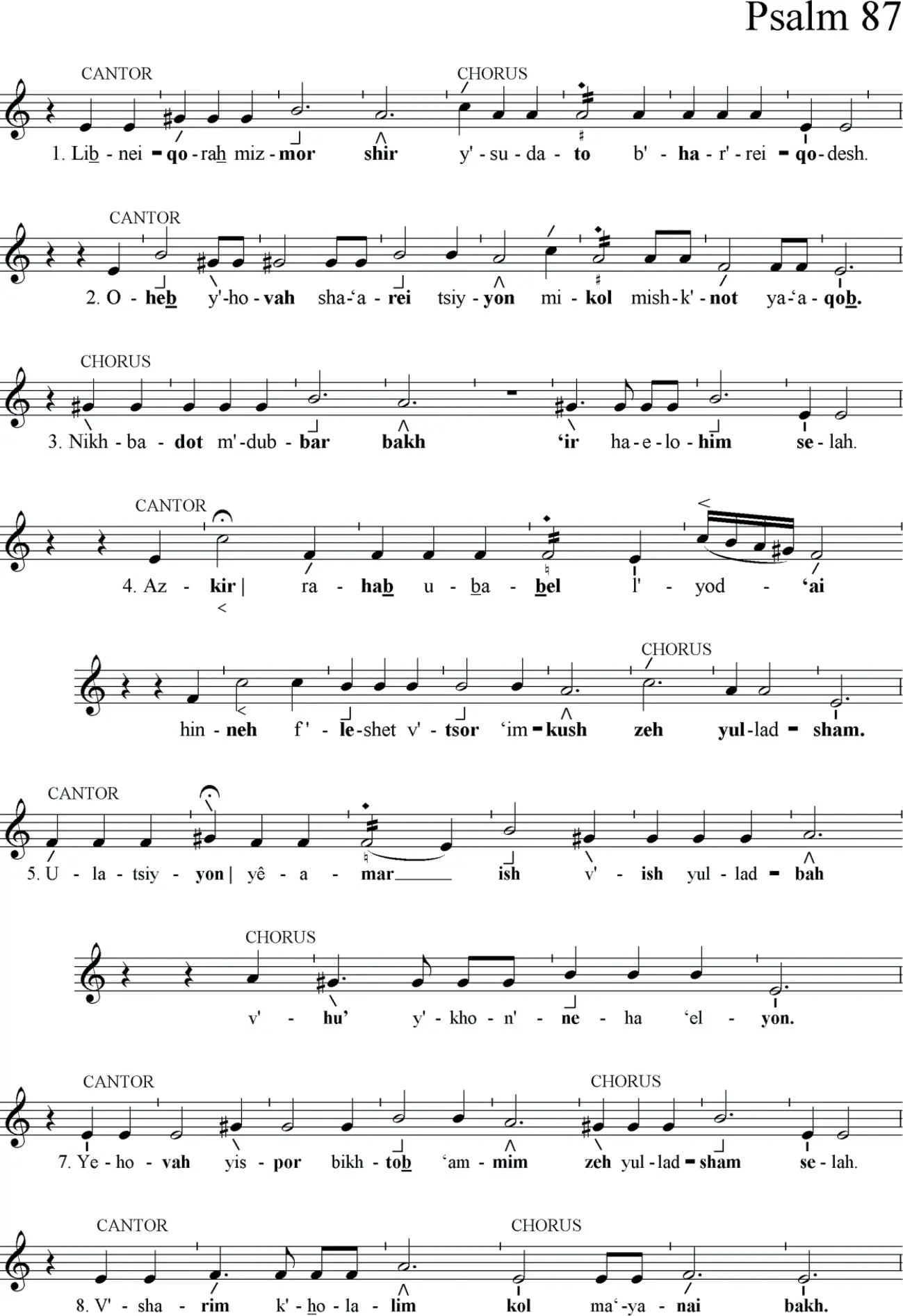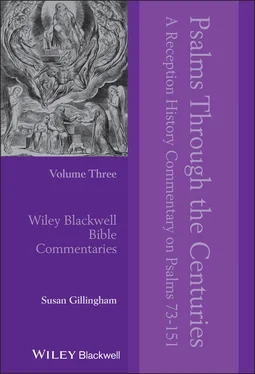*Targum omits such maternal implications. The ‘gates of Zion’ in verse 2 become ‘the gates of the houses of study that are fixed in Zion’, a particular reference to specific places for the study of the Law in the Diaspora. The end of verse 4 (‘This one was born there’) has a particular Davidic/Messianic reading in that Targum reads it as ‘ this king was anointed there’ . 232Verse 5 (‘This one and that one were born in it/her’) now reads ‘ King David and Solomon his son were anointed there’ . 233Later Jewish interpretation, represented by *Rashi, tends to look forward rather than back: making it clear that this is a promise that all exiles will be escorted home, Rashi argues that those coming to Zion from outside are only assimilated or converted Jews. This could be about proselytes, but it is not about the Gentiles. 234
In the light of the destruction of the Temple in 70 CE, Christians often read the psalm in a less physical way, understanding ‘Zion’ to mean ‘the presence of God’. This is clearly the case in texts such as Heb. 12:22–23, and although the psalm is not explicitly used in the New Testament, later writers read it in this light. The most obvious is *Augustine, for whom 87:3 (‘Glorious things are spoken of you, O city of God’) is the citation which opens his great work, The City of God . Seen in the light of the destruction of Rome in 410 CE, rather than the devastation of Jerusalem over three hundred years earlier, the sense of an enduring city, where the presence of God eternally dwelt, was paramount in Augustine’s thinking. 235*Jerome, meanwhile, sees the psalm (with its references to Rahab and Babylon in verse 4) as about the calling of the Gentiles: there is very little in common between Jerome’s sermon and the views noted earlier by Rashi. 236
An interesting link with the previous psalm is the reading of Zion in these verses as a reference to the Virgin Mary. An allegorical reading of verse 5 (‘this one and that one will be born in her’) is seen as referring to the Virgin birth, so that Mary becomes a type of Zion: in this reading the ‘streams of water’ in the Hebrew of verse 7 refer both to Jesus’ birth and to Jesus as the ‘living water’ in John 4. This theme, found in two adjacent psalms, is developed in Christian art, as we shall see.
This ‘birthing imagery’ in verse 5 also resulted in Psalm 87 becoming a ‘baptism psalm’, due mainly to its themes of entry into the church, the mission to the Gentiles, and the water imagery in verse 7. This liturgical use also influenced the composition of several hymns. One is ‘Jerusalem the Golden’, based on Psalm 48 as well as 84 and 87, by *Bernard of Cluny in about 1145. 237Another interesting use of 87:3 is found in a work by the eighteenth-century hymn-writer, John *Newton: his hymn, ‘Glorious Things of Thee are Spoken’ is used along with other texts such as Ps. 46:4 and Isa. 4:5–6 to speak of a spiritual understanding of the city at a time when nationalistic concerns needed to be addressed. Newton’s version was published in * Olney Hymns in 1779, and later it was used to the tune of *Haydn’s version of the Austrian imperial anthem, which in turn was based on a Croatian folk song. The same tune (known as ‘ Austria ’) was later used for the German national anthem. Hence just as *Luther’s adaptation of Psalm 46 was used in different ways to address sixteenth-century concerns about the church and state, so too Newton’s reading of Psalm 87 served similar eighteenth-century concerns; these were reinforced by the later adaption of the text to the same tune to serve German nationalistic interests. 238Psalm 87 can undoubtedly be read in very different theological and political ways.
The composer and musician David Mitchell offers a reconstruction of the Jewish liturgical and musical setting of this psalm from a time when these national concerns would have been more focussed on Jerusalem and its Temple. 239As we have seen previously, Mitchell uses the Hebrew diacritical marks to create a musical score, and this psalm is pertinent because it again offers several responsorial elements (for example, the citations about Zion in verses 4, 5, 6 and 7). 240In addition, the two occurrences of selah after verses 3 and 6 also allow for some dramatic musical interludes, perhaps with trumpets and cymbals, as with Psalm 82. Unlike Psalm 82, which is a typical Asaphite psalm in its sense of judgement, Psalm 87, as a Korahite psalm, has a clear festal mood, and is an ideal psalm for a reconstruction of Hebrew cantillation and performance. Whilst admitting that the stresses in the Hebrew do not inform us on this matter, Mitchell sets the psalm in triple time, arguing that either duple or triple time fits the rhythm well, thus bringing to life the psalm’s cheerful overall tone. The chorus and the (Korahite) cantor/precentor sing responsorially, in half verses, throughout. Mitchell’s creative adaption of the score in Figure 5 shows how the two halves of each verse are marked by mid-verse divisions indicated by an atnaḥ , represented as an inverted v: such a pause suggests a possible precursor to Christian psalmody sung as *plainchant. The score also reveals how the different notes (for example at the beginning of verse 4) have been extended for dramatic effect.

FIGURE 5 Interpretation of singing of Psalm 87 in its earliest setting .
Reproduced with the kind permission of David Mitchell, Director of Music in Holy Trinity Pro-Cathedral, Brussels; website https://brightmorningstar.org/wp-content/uploads/2020/06/Ps-087.pdf
The liturgical and musical use of the psalm was influenced by its different dramatic forms and its changing moods, and these provided ideal material for the interpretation of this psalm in art, where there are three dominant motifs. The most unusual of these is the so-called ‘Christianisation of Zion’—a theme which was encouraged by Church Fathers such as *Athanasius, whereby Zion is not only the Christian Church, or a type of the Virgin Mary, but Christ Himself. Hence in the *Khludov Psalter (fol.86v) David is represented as a prophet, standing before a Christian basilica set on high ground, with an image of the Virgin and Child on the walls. The inscription reads: ‘David prophesises’ (i.e., about the Incarnation). A second motif, as was seen in Ps. 86:11, is of the Virgin Mary. This is illustrated in the *Pantokrator Psalter (fol. 121r) where the inscription reads: ‘Holy Theotokos’ [or, God-bearer]—referring of course not to Zion, but to Mary. Other images of Mary as ‘Mother Zion’ are found in the * Barberini Psalter (fol. 149r) and * Theodore Psalter (fol. 115v). 241Perhaps one of the most telling images is in a twelfth-century manuscript by Jacobus ( Biblioteca Vaticana, gr.1162 ) which has a series of scenes where the Virgin Mary is questioned by Joseph: in one (fol. 170r) Mary is sitting, making her defence in silence, with an open book inscribed (in Greek) with Ps. 87:3. 242A third common motif is to read Zion in the psalm as the Christian Church. The *St Albans Psalter illustrates the upper ‘F’ of the first word of the psalm (‘ F undamenta eius in montibus sanctis ’) with a bishop and five clerics consecrating a church. 243
Of course, the alternative Jewish depiction in art is to read Zion literally, as the city of Jerusalem. Moshe *Berger’s image is of the ‘gates of Zion’ (verse 2) which are depicted abstractly, shining in blue and white with red, symbolising a portal to heaven through which the prayers of the people ascend to God and the blessing of God descend to the people. 244
Читать дальше













